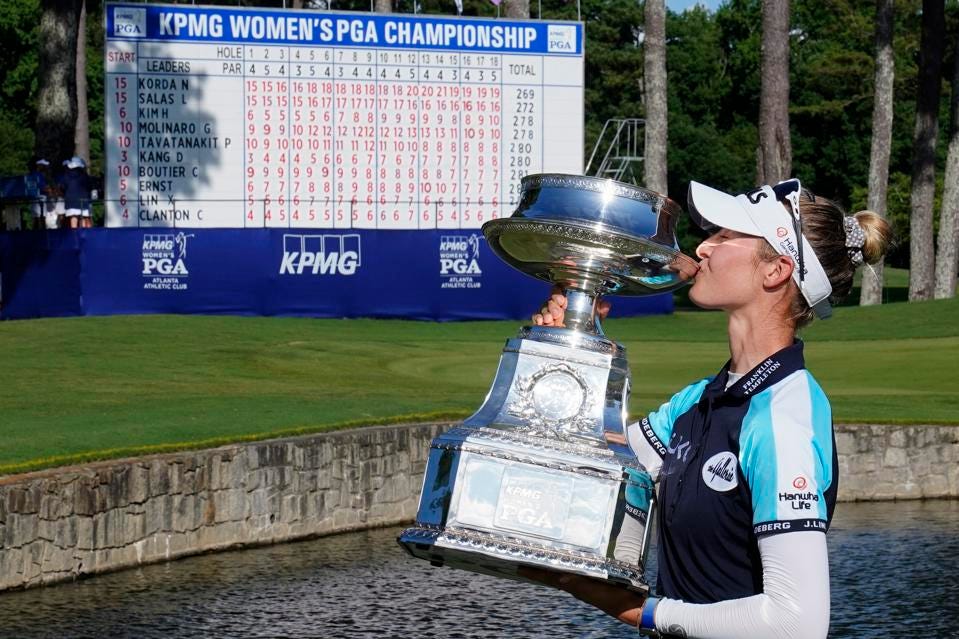The PGA of America, KPMG and the LPGA Tour just announced that this week’s KPMG Women´s PGA Championship, to be played at Congressional Country Club in Bethesda, Maryland, will pay out $9 million—exactly double last year’s purse. The winner’s share will also be twice as much as it was in 2021, rising to $1.35 million.
The major championship dates back to 1955, with the Big Four professional services firm KPMG taking over the title sponsorship reins eight years ago. While enriching the prize money by a less substantive figure would still have demonstrated a considerable commitment to the sport, supersizing the event’s pot makes a very clear statement: Driving purse size toward equity with the men’s game is a priority.
“While the purse size may not achieve equity with the men’s game in 2022, we certainly think about trying to explore ways constantly to be a catalyst for change and really be an example to other title sponsors of these events to try to drive women’s purses higher for the future,” KPMG U.S. chairman and CEO Paul Knopp explains.
The PGA Championship last month at Southern Hills, the equivalent event on the men’s side of the ledger, paid out $15 million. So there remains a lot of work to do before pay parity in pro golf is achieved, but with the accelerated track women’s purses are currently on, it wouldn’t be all that surprising for pay to equalize at some point down the road, although Knopp is reluctant to speculate by putting a timetable on it.
“We are trying to be a driving force for change that drives those purse sizes closer to Men’s purse sizes and hopefully some day in the future to be equal to Men’s purse sizes and particularly for the event that we are the title sponsor of. I really would find it hard to make a prediction exactly as to when that would be,” Knopp says.
With the deep-pocketed, Saudi-backed LIV Golf Series ponying up record-high purses, the goal posts to reaching pay equity also keep moving back.
“The problem is you are chasing an also increasing purse and there are dynamics going on in the game right now that are going to make that a little bit elusive. The Players Championship purse is now $20 million and the competing tour is $25 million and majors have always paid out significantly higher than week-to-week events and will be an increasing number as well which makes it that much harder to catch,” Seth Waugh, CEO of the PGA of America, explains.
“But I think it’s going to happen sooner than you think; I honestly do. I think it’s time. We’ve talked about equity for a long time. I worked on Wall Street for 35 years before I did this and we struggled with it too. We all want to leave the room better than we found it. We are firmly in the zip code and now just need to get to the same address,” he adds.
The Wednesday before the tournament begins, KPMG hosts a Women’s Leadership Summit onsite focused on advancing women in business into the C-suite. According to KPMG half of past participants have gone on to receive a promotion, including 32% to a C-level executive position.
This year’s closing keynote will be delivered by Indra Nooyi, Former Chairman and CEO of PepsiCo and other notable speakers on the docket include former Secretary of State Condoleezza Rice and Leanne Caret, who heads up the defense, space and security division at Boeing.
In 2007, Lorena Ochoa collected $4.3 million in winnings, which remains a single-season record on the LPGA Tour. The only other player in LPGA history to even cross the $3 million threshold in a season was Jin Young Ko last year.
But the tide is really starting to turn this season with multiple title sponsors markedly upping the ante on prize money. This season has already seen the U.S. Women’s Open purse spike to $10 million (up from $5.5 million), the CME Group Tour Championship raise their payout to $7 million (up from $5 million), and the AIG Women’s Open pump up their purse to $6.8 million (up from $5.5 million).
There seems to be a three-pronged approach to raising the bar for the Women’s game: bigger purses, better venues and more broadcast network coverage. As far as meeting those three performative pillars if Seth Waugh were to write a report card it’d be as follows: “I would say on the venues it’s an A, on the purse I think we went from a B- to a B+ or A- and on broadcasting, we are with NBC who is a great partner. I think the broadcast windows could be a little better and we obviously want viewership to get up so I’d say it’s probably a B there,” Waugh says.


Leave a Reply